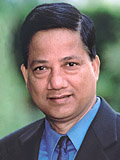News
» Go to news mainResearch profile: Shamsud Chowdhury

Dr. Shamsud Chowdhury
Professor and Area Coordinator, Strategy
How long have you been at Dal?
12 years.
Tell us about your research and what drove you into those topics.
My research involves four distinct but related streams that revolve around strategy and competitiveness: turnarounds and decline, board leadership structure, executive compensation, and path-dependence. During my course work at the PhD program, University of Kentucky, I became interested in turnarounds and decline. I developed an interest in the second and third topics largely because of the level of theoretical and methodological sophistication required to handle these topics. The fourth topic is an offshoot of the first. I am particularly interested in these four topics because of their relevance for our practising top managers.
Ěý
Can you share with us some of your works-in-progress?
I am working on five different projects, three of which are based on published, secondary data. The first is a longitudinal analysis of changes in choice and determinism dimensions of the organizational task environment, which has been underway for about two years. The second project deals with the type of stock exchange and compensation structure of outside directors in large Canadian corporations. The third focuses on executive hubris, groupthink, and path-dependence. The fourth deals with how the reversal of board leadership structure mitigated the effects of corporate espionage in WestJet and Hewlett-Packard. My fifth project is a field-based case study of Halifax Port Authority and the Seaport Farmers’ Market. These projects are in different stages of completion and publication.
Ěý
How does your research affect business practice or what are some of the implications for the real world?
By definition, as a discipline, strategy evolved from the practical work of very successful consultants. I believe my research is very relevant for our practising managers. Consider this famous quote from Michael Porter: “The reason why firms succeed or fail is perhaps the central question in strategy” and its relationship to turnarounds and decline. Therefore, the first stream of my research is very useful for business managers. The second and third streams are directly related to my corporate governance courses at the undergraduate and graduate levels. As a matter of fact, I use some of my research findings in those two areas in my governance courses. These two streams have direct bearing on a number of issues such as corporate espionage, executive wrongdoing, corporate citizenship, and ethics that affect our life, livelihood, morality, and values.
Ěý
How does your research impact and support/enhance your teaching?
Ěý
I have provided part of the answer in my response to the fourth question. The key point here is that teaching and research are intertwined. I carefully craft my lectures and integrate my research findings into them so that they are lively and appealing.
Ěý
What would you consider to be a research success?
Ěý
To be recognized and admired by colleagues for publications in high-quality journals. Given the widening difference between high- and low-quality journals, this emphasis is very important. It takes about four years to publish in a high-quality journal in business/management. In this time, you can have 15 to 20 articles to your credit in journals of questionable quality, though none may be acceptable to a high-quality journal. Quality publications require ability and intellect; poor publications require a hunt for obscure journals. Ěý
Ěý
What advice would you give to fellow young researchers?
Ěý
Stick to your passion and nurture quality in your work. Don’t publish in rubbish outlets.
Recent News
- Two Bachelor of Commerce graduates on the importance of extra‑curricular activities and people skills
- Knowing her worth: Kayler Mutyabule
- Patrick Law: Pivoting cross‑country
- Building on passion: Francesca Hawkes
- Taking it further: Rebecca Osamudiame
- Isioma Oye‑Onwuka: A student profile
- Q&A with Dana Kabat‑Farr
- Himanshu Kumar: A student profile
